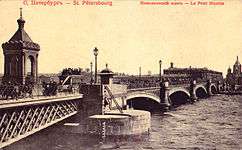Stanisław Kierbedź
| Stanisław Kierbedź | |
|---|---|
|
| |
| Born |
March 10, 1810 Samogitia |
| Died |
April 19, 1899 (aged 89) Warsaw |
| Nationality | Polish, Russian |
| Occupation | Engineer |
| Known for | Bridges, ports, railways |
| Children | Eugenia Kierbedź |
Stanisław Kierbedź (Russian: Станислав Валерианович Кербедз; 1810-1899) was a Polish-Russian engineer and military officer. He served in the Imperial Russian Army with the rank of Major General. He designed and supervised the construction of dozens of bridges, railway lines, ports and other objects in Central and Eastern Europe.
Early years
Stanisław Kierbedź was born into a land owning family in Samogitia. He was a piarist student in Panevėžys, and in 1826 he graduated from high school in Kaunas. Then, from 1826 to 1828, he studied mathematics and physics at the Imperial University of Vilnius.
Teaching activities
After graduating, he went to Saint Petersburg and in 1831 graduated from the Institute of the Corps of Engineers Communications, where he later lectured in construction and practical mechanics as an assistant professor from 1837 to 1849. From 1834 he lectured on those subjects to classes of officers of the Main School of Engineering.
From June 1837 to September 1838 he traveled with Professor D. Melnikov to many European universities. He visited Germany, Austria, Switzerland, France (including in Paris at the Ecole des Ponts et Chaussees), England (with classes at the British Association for the Advancement of Science in Newcastle upon Tyne), Belgium and the Netherlands.
After his return he continued his activities as a lecturer at the Institute of Mining, the Warsaw School of Engineers in the Field, and in the School of the Marine Corps. From 1841 to 1843 he taught general mechanics at the University of St. Petersburg.
As a result, he had more and more involvement in the practical use of this knowledge, and mainly stopped teaching in 1849.
Practical activities
Under his leadership, work on the St. Stanislaus's Catholic Church in St. Petersburg was performed. Kierbedź also worked at the time as an assistant to Professor Melnikov, who was Director of Railways.


In 1842 he came up with the idea to build an iron bridge over the Neva River. The project was risky because of the construction conditions: a 12 meter deep river, with a strong current, ice floes in the winter, tidal waters, as well as the need to keep the river available for ships. Experts doubted at the time whether it is possible to build any bridge over the capricious river. The decision to entrust its construction to Kierbedź was taken by Tsar Nicholas I directly. Construction took 8 years and St. Petersburg gained a bridge 342 meters long, 20 meters wide, made of cast-iron with seven fixed spans and one drawbridge. It was named the Blagoveshchensky Bridge (later renamed Nikolaevsky Bridge after Tsar Nicolas's death). On the opening day of the bridge (on 18 November 1850), Kierbedzia was awarded a specially stamped medal and appointed to be a Major-General.
He also gained recognition in the scientific community - Stanislaw Kierbedź was a corresponding member of the St. Petersburg Academy of Sciences (the department of physics and mathematics), and from 1858, an honorary member.
In 1852 he became deputy director of the construction of the Saint Petersburg – Warsaw Railway and went abroad in order to familiarize himself with new technologies and ways of building iron bridges, to help build the new railway. He visited England, Germany, Austria and Belgium. He soon took advantage of this knowledge, building his first truss bridge with a span length of 55 meters over the Luga River from 1853-1857.
From 1856 to 1859 he participated in the construction of the railway branch from St. Petersburg to Tsarskoye Selo.
In 1859 he started the construction of a permanent iron bridge (the first) over the Vistula River in Warsaw. Stanislaw Kierbedź was deputy head of technical matters on the Bridge Construction Board along with General-Adjutant Count Paul Demetrius Kotzebue. The bridge was completed in 1864 and officially given the name "Alexander Bridge" (after the reigning Tsar), but was commonly known as the Kierbedzia Bridge. Caissons were used to build the pillars for the bridge which was an unusual construction technique at the time.
In 1863, Kierbedź was recalled to St. Petersburg as a member of the Ministry of Transport, and nine years later the president of port construction in Kronstadt, St. Petersburg.
In 1881 he was appointed as Actual Privy Councilor which allowed him to substitute repeatedly as Minister of Transport (from 1886 to 1887). After many years of work in 1889 he was awarded with an honorary membership in the:
- The Institute of Communications Engineers in St. Petersburg, which also funded three scholarships in his name
- The Communication Engineers Association, which established the prize named after him, awarded every three years for the best technical articles
A scholarship in his name was also funded by the Warsaw University of Technology.
In 1891 he retired and settled permanently in Warsaw, where he died on April 19, 1899. He is buried in the Powązki Cemetery.